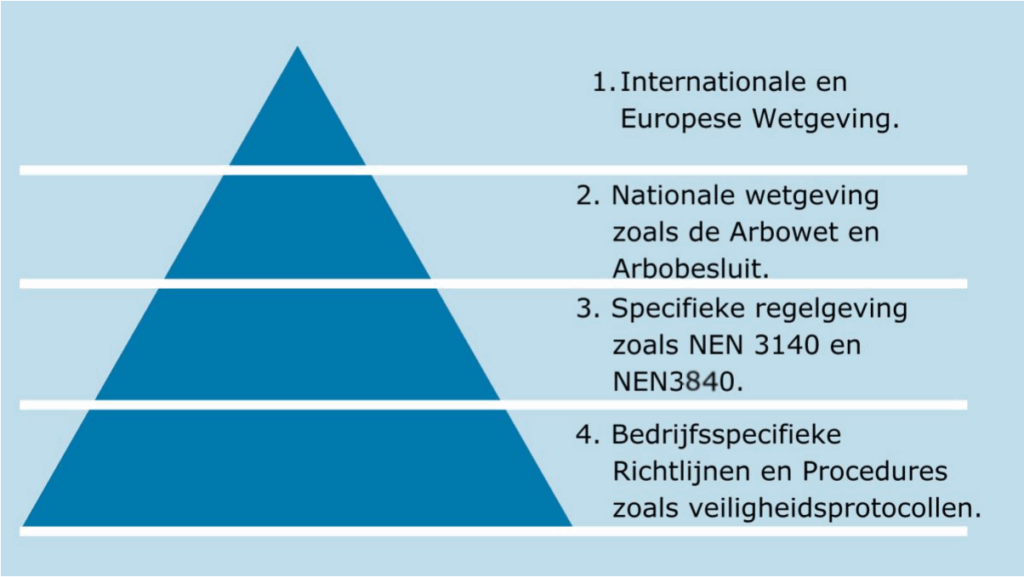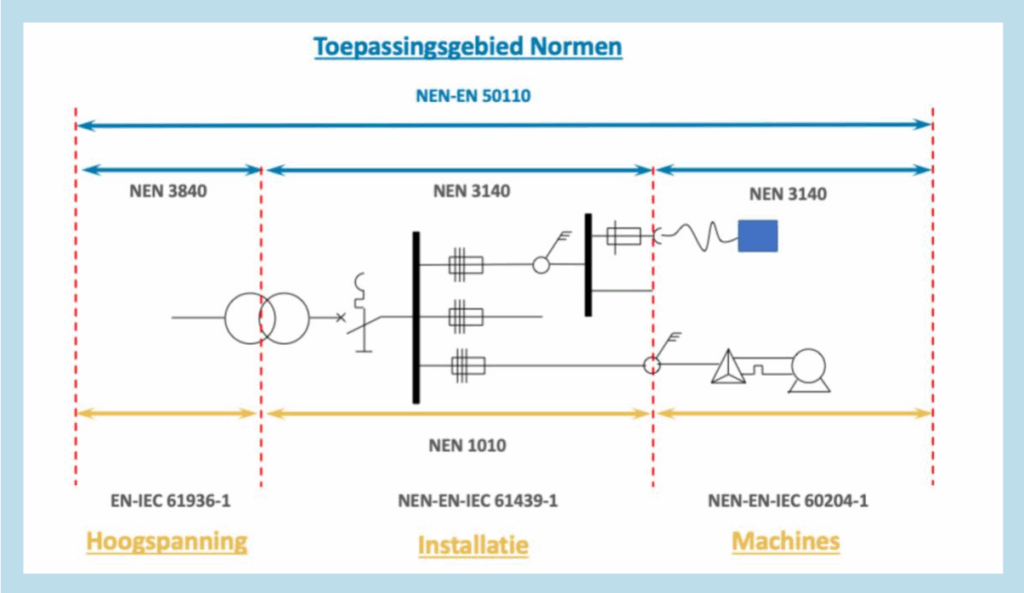Short introduction how does it work for you as Industry Director or VP or Plant Manager.

Electrical Installation Compliancy, Legislation and Regulations
1. Europe and International rules are general rules.
- EN 50110 describes EU rules for Electrical Operations for High- and Low Voltage
- EN 61936-1 describes EU rules for High Voltage Installations
- EN 61439 describes EU rules for Low Voltage Installations
- EN 60204-1 describes EU rules for Machine Standards.
2. Countries have there law’s with details and targets.
- In the Netherlands Electrical Safety is a Fundamental part of the Labor Law and it’s an Obligation to adapt it in your organisation. The Labor Law has general provisions which lay down the responsibilities and obligations of employers and employees in the field of working conditions
- The Working Conditions Decree, also known as the “Arbobesluit”, is an elaboration of the Arbowet, It contains the specific rules that employers and employees must adhere to in order to prevent or limit occupational risks that mandatory needs to be followed up by the organisation and these rules are annual under progress depending on latest technology meant to increase safety, free translated this is the “Labor Law decision List”
- Here is stated that risk has to be prevented by the source and not by PBM’s, PBM’s are only allowed if there are no other options left, it is also stated here to choose the most safest option first above all other options.
Violations of the Labor Law or Labor Law decision list that ends up in Injury or death of employee(s) will be investigated by a government (SZW) Labor Inspection team and will end up in a court of Low and a Fine or in Prison for the Director of the Organisation.
During this Incident Investigation the production can be SHUT DOWN for a long time until the Investigation report is ready and succession of the action list has completed.
In the Labor Law decision List Item 3 there are two special article for Electricity rules (defined by law so mandatory)
- Item 3.4 is about the Electrical Installations,
- This includes ensuring safe design, layout, installation, maintenance and marking.
- There must be effective measures against hazards such as
- Fire,
- Explosion,
- Direct and indirect contact,
- Too close approach.
- Item 3.5 is about work on the Electrical Installations,
- This article focuses on safety when working on or near electrical installations.
- Only skilled and authorized employees may perform dangerous work.
- Work on high-voltage installations requires special measures and supervision.
- There are also rules for working under voltage at low-voltage installations, but this is only permitted under strict conditions.
3. Countries also have there local Standards, they are aligned to the European Standards, these are fully detailed.
The Standards are agreements made regarding safe and healthy working The Standards are in fact agreements within a certain industry. There are Global Standards (IEC), European Standards (EN) and there are Dutch Standards (NEN)
For the Netherlands we have below NEN standards.
- NEN 3840 describes rules for Electrical Operations High Voltage
- NEN 3140 describes rules for Electrical Operations Low Voltage and Machines
- NEN 1010 describes standards for Low Voltage Installations
- NEN does not have a local standard for High Voltage Installations, here the IV-HS was Responsible for the HV design and shall be able to explain the design in a court of Law. Now we need to align to the EN 61936-1 EU rules for High Voltage Installations.

In NEN-3140 and in NEN-3840 and in EN-50110 (Top to bottom of Piramide) is stated that the Industry Director must delegate his Electrical Installation responsibility to a Manager in Control of the Electrical Installation (IV) for the following Tasks:
Maintaining the safety of electrical installations and electrical equipment by:
- Performing periodic inspections and timely repair of defects.
- Setting up access arrangements for areas with an electrical hazard.
- Establishing procedures for operating installations.
- Approving plans for carrying out work on “his” installation(s).
- Giving permission before work is carried out on “his” installation(s).
- Assessing whether the installation complies in the event of a change in use or circumstances.
- Assessing whether inspection results affect the RI&E or the associated Plan of Approach.
- Assessing whether the business operations permit all parts of an installation to be de-energised before work is carried out.
Responsible for the Electrical Organisation so IV has to to sign off the periodic Designation forms for HV and LV for the following persons:
- The Backup Operational installation manager (OIV)
- The Work Manager (WV)
- The competent persons (VP)
- The sufficiently trained persons (VOP)
Key Acces policy to Electrical HV and LV rooms
Writing and/or Signing off Switch Letters for HV and LV main Distribution IV Work in alignment with the Work Manager (WV).
IV needs to organize Periodic Electrical Training for the entire Organisation
When both the Director and the Manager in Control of the Electrical Installation (IV) have signed of the Designation form for a period of time the Director is no longer the Legal responsible for electrical incidents and the Manager in Control of the Electrical Installation (IV) is now direct responsible for the Electrical Installation in a Court of Law.
As a matter of speaking here the Director has delegated his responsibility to the IV-HV/LV. Here HV and LV can be combined in one person but can also be split in two persons. There can be an Operational IV (OIV) as backup for the IV but the IV remains End-Responsible in here.
EC can be your IV-HV/LV Manager in Control of the Electrical Installation to which you can to delegate your Legal Electrical Responsibility.
EC can also hand out VP and VOP Training Onsite or Inhouse in our facility in Edam
4. Companies may have there additional own rules, standards and procedures
They cannot be in conflict with the minimum safety standards as defined in the Piramide-up direction. One example is a Standard operating procedure (SOP) for i.e. replacement of an electric motor.
In the Netherlands annual two persons die on Fatal Electrical Accidents, seven remain with severe injury due Incidents with Electricity and twenty four recover from there injury, this is only the 10% top of the iceberg, invisible there is a huge 90% number of ~ 288 pcs. of near miss electrical human incidents for every year.
In total this is 320 electrical incidents per year.
Download below Factsheet to see the total amount of annual electrical incidents table related to the above recorded Incident numbers.